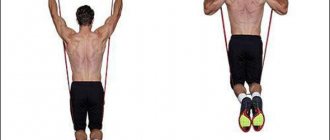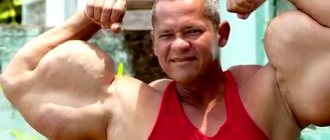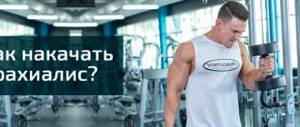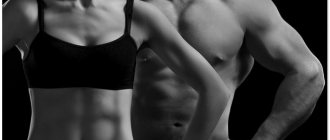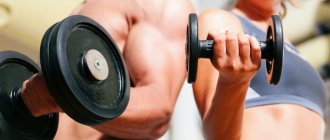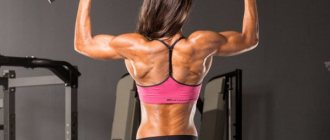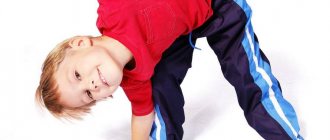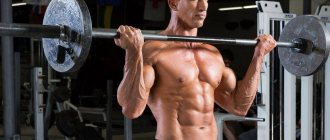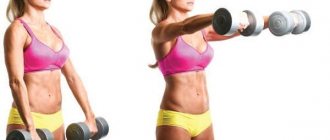How to pump up your biceps with pull-ups on the horizontal bar
Pull-ups on the bar are the most common exercise not only for developing a broad back, but also biceps. In addition, this is the most affordable training option, since there is a crossbar in every yard, and hanging a horizontal bar at home is also not difficult. Pull-ups for biceps and back should definitely be present in the training complexes of both experienced athletes and beginners.
Features of training on the horizontal bar
On the horizontal bar you can conduct complex training of different muscle groups. Today there are a huge number of exercise programs, following which you can quickly get in shape. If you plan to train at home, then the simulator should be selected “for yourself,” that is, taking into account the individual characteristics of the body and the planned activities. The most common option is a suspended steel horizontal bar. Usually it is hung in the doorway and practiced at any convenient time.
Important! Experienced athletes recommend performing exercises on the horizontal bar, including biceps pull-ups, wearing special gloves. This will protect your hands from injuries, calluses and slipping.
The effectiveness of training on a regular horizontal bar is very high. By exercising regularly, you can quickly create sculpted biceps.
We also recommend studying this topic:
How can you do pull-ups on a horizontal bar? Main types and technique of execution
9169 0 0
Readers found these materials useful:
- Some of the coolest exercises for pumping up your arms
- A set of effective exercises for pumping up a girl’s arms
Is it possible to pump up your biceps with pull-ups?
First of all, you need to study the anatomy of the exercise. When doing pull-ups with a wide grip , the latissimus dorsi muscles, the teres major muscle are contracted, and the rhomboid and lower trapezius are involved in bringing the shoulder blades together at the top point. It also works the biceps, brachioradialis and brachialis muscles, which help perform pull-ups.
Although the biceps performs its functions, this exercise develops the back to a greater extent, and the difference in grip corrects the development of the latissimus muscles in width or thickness. But there are also subtleties in pull-ups with a narrow reverse grip. When doing a biceps pull-up , you don’t have to bring your shoulder blades close to each other and don’t aim your sternum at the bar, in which case the biceps will be more involved in the work.
The peculiarity of pull-ups is that the shape of the muscles directly depends on the position of the torso.
- If you pull yourself up to your chin, with your torso perpendicular to the floor , then the width of your back will develop, in other words, “wings.”
- If you stretch the center of your chest towards the bar, bringing your elbows back behind your back , the thickness of your back will be formed to a greater extent.
These exercise options do not particularly affect the shape of the biceps.
Read more about the pull-up exercise in this article →
Basic Training Ideas
No matter how hard you try, you must understand that you won’t get pumped up in a week, but it’s easy to get injured with an “overdose” of training. It’s
important to tune in to the frequency of the need to pull yourself up and expect visible results only after a while - different for each age
Technical Tips:
- Before starting training, do a warm-up to warm up your muscles;
- Do not under any circumstances arch your back or reach for the horizontal bar with your chest, as you may end up getting injured;
- the shoulder blades cannot be retracted;
- don't swing;
- do not forget about constant breathing control;
- exercises should be smooth.
Wide-grip pull-up technique to engage the biceps
Vary your chest or chin pull-up technique depending on your goals. Perform pull-ups until your muscles are completely tired; for muscle growth, it is recommended to work in 4x12 mode.
- Grasp the horizontal bar with a wide grip, placing your palms in a regular overhand grip.
- Exhale: bending your elbows, pull your chin towards the bar, squeezing your shoulder blades at the top point. Keep your legs bent at the knee.
- Inhale: slowly lower yourself without fully extending your elbows.
Option for pumping up biceps on the horizontal bar No. 2 - pulling the back of the head to the bar
- Place your palms with a wide grip on the bar.
- Exhale: bending your elbows, moving them slightly back behind your back, pull yourself up so that the back of your head touches the bar.
- Inhale: lower your torso smoothly, without jerking.
Also repeat in 4x12 mode, avoid too many repetitions.
Recommendations
It should be noted that in many modern gyms there is a special block simulator for pull-ups with a “Gravitron” counterweight. For beginners , both men and women, who cannot do pull-ups with their own weight, the machine will be an excellent assistant in mastering the technique of pull-ups. Gradually, the load can be increased by setting the required number of counterweight blocks that push the body.
Pumping up your biceps on the horizontal bar is not the most convenient thing, unlike working comfortably in exercise machines. The technique requires strong hands, that is, a tenacious grip, and strong forearms, so many find it difficult to keep their palms on the bar for the required amount of time. Therefore, use special loops for brushes . By putting a loop on your hand and tying it around the bar, you can significantly ease the fate of your hands, extending the time for working on the muscles.
If pull-ups with your own weight are very easy for you, wear a special belt on which you can hang additional weight , and perform the required number of repetitions. Perhaps it will be more difficult with each approach, then you can reduce the repetitions by: 12, 10, 8, 8–6 times.
Pull-ups are one of the most difficult exercises for the back and arms, so start your workout with this exercise, because in the middle or end of the training, when the muscles have already worked, it will be difficult to do a pull-up and the muscles will refuse to work to their fullest.
On the subject: Muscles of the arm, head of the biceps
How to pump up biceps on the horizontal bar
We have already discussed the structure of the biceps brachii muscle in this article: “How to pump up biceps at home,” but we had to remove some exercises due to the fact that not everyone has a horizontal bar at home. Training on the horizontal bar is a universal way to pump up the upper body, because when lifting yourself to the bar, many muscle groups are involved.
Exercises
1) The first exercise to pump up the biceps brachii muscle will be “ Undergrip pull-ups
". But unlike regular underhand pull-ups, when performing this exercise, try not to go below 90 degrees at the elbow joint. This way, your muscles will be under tension longer. It is also advisable to use weights for greater effect. Secondly, during repetitions, additionally squeeze your biceps. Thirdly, round your back so that the biceps muscle takes up more work. Perform this exercise 8-12 times for 4 sets.
2) For the second and third exercises, do wide and narrow pull-ups with a reverse grip
. Different arm positions will use different heads of the biceps muscle and in this way you will work the inner and outer sides of the biceps. It is better to perform such variations of pull-ups in the same proportions: 12 times, 3-4 approaches.
3) For the fourth exercise, do narrow pull-ups
, but with
an overhead or regular grip
. When performing such a pull-up, make sure that the distance between your hands is 5-7 cm. Also spread your elbows in different directions. This type of pull-up will work your brachialis, which will make your arms wider. Do 8-12 repetitions for 3-4 sets.
4) The fifth exercise will be a static biceps hold.
. To do this, you need to pull yourself up on the horizontal bar with a reverse grip and hover in the highest position. Then move your body away from the horizontal bar a little and hold this position until you begin to release. This exercise should be done for one approach at the end of the workout.
If you are interested in sports, I recommend reading these articles:
Source
3 Exercises on the horizontal bar for biceps Fitness at home video lessons, exercise, proper nutrition
With the help of pull-ups on the bar, you can use different muscle groups, which include: trapezius, deltoids, latissimus dorsi, biceps and triceps, pectoral and abdominal muscles.
And now the main question is how to pump up your biceps muscles on the horizontal bar using pull-ups.
The starting position of this exercise is hanging with a slightly arched back. Legs should be bent at the knees and crossed together.
SUPINATE NARROW GRIP
The grip on the horizontal bar should be slightly narrower than the width of your shoulders. The most difficult thing is when the hands touch and there is no distance between them. In this case, the shoulders should be slightly lowered and look back. When you pull yourself up, bring your shoulder blades together, your lower chest should touch the bar, and your chin should look above the horizontal bar.
SUPINATE MEDIUM GRIP
This exercise involves placing your arms at the width of your shoulders or slightly wider. This technique is very similar to a close grip, only when lifting you should touch the bar with your upper chest.
PARTIAL MEDIUM GRIP
This grip requires a partial pull-up. Such pull-ups do not involve maximum lifting of the torso, but to the midpoint of the amplitude.
When you have reached this point, you should stay in this position and bend your forearms, while trying to get your collarbones very close to the horizontal bar. The partial mid-grip is very effective in building biceps.
Helpful advice!
First, the muscles help lift the body, and then tense when you fix the torso.
Biceps on the horizontal bar are built up using the following rules:
- Pull your torso with your muscles, not with inertia.
- Do not swing your body under any circumstances.
- Rise slowly, without a sharp jerk, and also lower yourself.
- Remember about proper breathing. When you rise, exhale, and when you fall, inhale. You cannot hold your breath.
- Don't forget about the mandatory warm-up before training.
MANDATORY RULES
If you train your body correctly, you can effectively build your biceps with pull-ups. The results will come faster with the correct pull-up technique.
1. NORMAL TRAINING 2-3 TIMES A WEEK, AS WELL AS COMPLETE REST.
If you do not give your muscles rest to recover, then their growth will definitely not occur. If the muscles are very sore, then this is a sign of further microtraumas and stretch marks, which means that if you go to training, it will not be effective.
2. MONITOR THE NUMBER OF APPROACHES AND REPEATS.
Pull-ups are work with your own weight, which is very difficult to do at first. In order for your muscles to build up, you need to do at least 3-4 sets of 8-12 repetitions. This does not mean that you should exhaust your muscles from the very first workout. To begin with, you need to do as many repetitions as possible, and gradually increase the number of repetitions over time.
3. REST FOR ABOUT 2-3 MINUTES BETWEEN SETS.
4. LOAD RESULTS.
How to continue performing biceps exercises after the muscles have stopped responding to loads? Try focusing on weights. For example: you can try doing pull-ups using a backpack. Another option is a belt that allows you to hang weights and weights from it. Remember that the more you burden yourself, the fewer repetitions you should perform.
FOCUS YOUR ATTENTION ON THE BICEPS
6. MONITOR YOUR PROTEIN IN YOUR BODY.
Protein is the key to success in building muscle. It is important for recuperation.
7. TECHNIQUES OF PERFORMING BICEPS EXERCISES.
If you break all the rules of pull-ups, you not only risk decreased effectiveness, but you also risk a lot of microtrauma.
Remember not to overload your biceps muscles and do all these 3 exercises in one workout. You can spread them out over several days. Start with a close grip first, and the next day train with a medium grip, on the 3rd day do partial pull-ups with a medium grip.
Pay attention!
This load distribution should be based on the grip width. There is a supinated grip - the one that is below the crossbar, and a pronated grip - the one that is on top of the crossbar, and the width is distinguished - narrow, wide and medium. A narrow grip engages the muscles of the arms, shoulders and chest, while a wide grip allows you to build up your back muscles.
If you are pursuing the goal of building up your biceps using a horizontal bar, then the best option would be a supinated grip. Then you will pump up the biceps brachii muscles, building up your biceps.
How to pump up your biceps on horizontal bars
It is very easy to pump up your biceps on horizontal bars. You just need to know a couple of exercises that will make your biceps grow quickly. I made a workout out of these exercises!
This article will describe one workout with a set of exercises on the horizontal bar that will perfectly pump up your biceps!
First, I will describe the training itself, and then I will describe all the subtleties and special techniques of these exercises.
Don't forget
It's good to warm up before training, it will be very good if you go for a run. Also, don't forget to bring a bottle of water to your workout!
Increasing the number of approaches
One of the most pressing problems for beginners is the number of pull-ups on the horizontal bar, which is often quite small. And someone is not able to do one pull-up
In this case, it is important not to despair, but to immediately take action. So, if you don’t know how to do pull-ups at all, leave the horizontal bar aside for the first time
And slowly develop your own arms using various dumbbells and various types of exercises - push-ups are perfect. Soon after this, at least once, you will definitely be able to pull yourself up. The best option would be if you manage to build a crossbar in your apartment, and every time you are nearby, you try to pull yourself up.
But to increase the number of pull-ups, you need to act a little differently. Firstly, do not forget about the correct training program. This will help to properly distribute the load. Secondly, try increasing the weight. Weighting agents are used for this. If you don’t have special ones at hand, take a briefcase and put some weight in it. Try to pull yourself up. The heavier the load becomes, the more pull-ups you can do without it.
Execution technique
- Reverse close grip pull-ups.
Do not fully extend your arms. This is necessary to use your back to a minimum. Also try to pull yourself up perpendicular to the ground, since when you pull yourself up in an inclined position, your back takes the main load. - Head pull-ups.
At the top, be as tense as possible to pump up the peak of your biceps.
- Australian pull-ups with reverse grip.
Typically your elbows will go behind your back. Try to move your elbows up, rotating your grip. This way you will use your biceps as much as possible. This exercise is more convenient to perform on rings, but the horizontal bar is in no way inferior to them.
Quite a short article, but I hope you learned some new information. Thank you, read my other articles and good luck!
Source
How to do biceps pull-ups or why don’t biceps grow?
Today we have a secret trick on the menu that will help you make pull-ups and rows with a narrow reverse grip effective for growing biceps.
For some reason, everyone thinks that vertical rows and pull-ups with a wide grip are training the latissimus dorsi muscles, and pull-ups and pull-ups with a narrow reverse grip, or “palms facing you” grip, are training the biceps! I thought so myself as a teenager until I read Mike Mentzer's training book. The famous bodybuilder believed that close-grip deadlifts were the most effective exercise for developing a broad back.
On topic: Exercises for ballerinas for arms
In fact, it’s not difficult to figure out what role the back plays in pull-ups with a reverse grip, and what role the biceps plays. Perform 8 reps of pull-ups to failure. So you can estimate how much weight you can lift with your back and biceps at the same time.
Then you will need to figure out how much weight you can lift on a Scott bench, that is, in isolation, without the help of your back. After all, even in standing biceps lifts without cheating, the back and abdominal muscles play a big role. Even by imperceptibly swinging our body, we can easily add 5 kg in biceps curls!
In regular biceps pull-ups, the back takes up to 75% of the total load!
As a rule, a person capable of doing pull-ups with his own weight of 80 kg for 8 repetitions “palms facing himself” will lift 25-30 kg on a Scott bench using a strict technique. It turns out that more than 65-70% of the load in pull-ups is for the biceps, it is not the biceps at all, and this exercise is not effective for training the arms.
From mathematical theory, I propose to move on to muscle anatomy. The main function of the biceps brachii is to flex the arm at the elbow joint. The main functions of the latissimus muscle are extension and adduction of the shoulder. This means that with any pull where our elbow joints are brought to the body, no matter through the sides or the front, the function of the latissimus dorsi muscle will be involved, and the movement will no longer be produced mainly by the biceps.
From this we can draw the only possible conclusion: if our goal is to pump up the biceps with pull-ups, then we must manage to minimize shoulder adduction and maximize arm flexion at the elbow joint.
And if we do pull-ups or pull-downs, pulling the bar or bar much lower than our chin, our elbows will inevitably diverge to the sides and be brought toward the body, and the function of bending the arm will become secondary.
Therefore, we will need special biceps rows or pull-ups.
Source
Types of squats
Let's describe the different types of squats for training.
For beginners, squats with dumbbells will be appropriate for training the hamstrings. When performing them, do not forget that your back should be perfectly straight, and your body should not be tilted forward. The feet should be kept parallel to each other, placing emphasis on the heels. The arms are always straight, lowered along the body and holding dumbbells.
The essence of Bulgarian squats is to squat on one leg while the other leg is fixed on a hill.
The squat technique involves concentrating the entire load on one leg, thereby increasing the effectiveness of the workout. Let's look at the details.
Starting stance: you need to go to the bench (you can use any convenient elevation) and turn your back to it. Place your right foot on the bench with your toe down. Take a step forward with your left foot so that you can then do squats comfortably. Hands along the body, gaze directed forward.
From the starting position, begin to do squats, lowering the knee of your right leg down and bending your left leg. Then push up with your left heel.
If your body is ready for more serious training, try barbell squats to strengthen the outer quadriceps. It is advisable to perform squats under the supervision of an instructor, as incorrect technique can lead to serious injuries. This is a non-isolated workout for the hamstrings; some of the back and buttock muscles are also actively involved.
Method of execution: stand straight, feet shoulder-width apart or even slightly wider. Place the barbell on the trapezius muscle and begin squats - as if you want to sit on a stool.
Important:
- The back must be straight, otherwise the load will be immediately redistributed.
- Focus on your heels, do not lift your toes off the floor.
- Sit down until the thigh-shin angle reaches 90 degrees.
- Do not extend your knees further than your toes.
- The abdominal, lower back and buttock muscles are always tense.
A beautiful body is not a gift of fate, but the result of hard training and the fight against one’s own laziness. We told you how to quickly build up your biceps, but it will be much easier to do this if you not only exercise regularly in the gym or at home, but also eat right, giving preference to protein foods and long-lasting carbohydrates. It is the combination of a healthy diet and regular physical activity that will give you the dream of all exercisers - peak biceps.
A little about the horizontal bar and biceps
So, is it generally possible to pump up arm muscles on the horizontal bar?
The answer to this question is ambiguous. The fact is that the horizontal bar will not help you gain large muscle volumes. But, it will make your body strong and sculpted. That is, you won’t grow much in size, but you will certainly look more pumped up, muscular and athletic.
If you show a lot of persistence, you may be able to increase the thickness of your arm by a couple of cm. But without heavy basic exercises, you will not gain significant mass.
The same applies to the biceps. The main problem with pumping up your arms on the horizontal bar and parallel bars is limiting the load with your weight. Look at athletes doing street training. They are not at all swollen. They are dry and textured.
And many people have this form not due to exercise or nutrition, it is a certain type of organism. Initially, a heavy person will not climb onto the horizontal bar to do pull-ups and do various acrobatic feats, simply because for him, with his weight, it is very difficult. Those guys who are initially good at the horizontal bar usually go to workout.
The horizontal bar and parallel bars are suitable for those who want to keep their body in shape and have strong and strong arms. If you want mass, go to the gym. Grab the barbell and go!
Since our article is dedicated specifically to the horizontal bar and hand work, we will analyze this topic in detail. We will talk about how to pump up your biceps on the horizontal bar, however, by the word “pump up” we mean: strengthen, make stronger, more prominent and defined. Get a few cm in volume as a bonus.
Biceps exercises
If you are eager to know how to quickly pump up your biceps on the horizontal bar, understand that in sports only injuries happen quickly. The muscles will not have time to strengthen in a week. Our task is long-term and requires patience - to systematically pull ourselves up.
On topic: Push-up pattern for arm muscles
With all types of pull-ups, in addition to the arms, the back muscles will be involved in the process. With a wide grip, they will take on the main load. Any exercise on the horizontal bar affects the biceps, brachialis, and back.
The most correct way to work the biceps is to do pull-ups with a narrow reverse grip. To work the entire volume of the biceps muscle, you also need to do pull-ups with a parallel grip, with your palms facing each other. In outdoor conditions, this is only possible on horizontal ladders. If you have one of these in your yard, be sure to combine close-grip pull-ups with this type.
Correct bicep pull-ups
To affect your back less and your biceps more, you need to pull up in a certain way.
To understand how to do pull-ups correctly and how to pump up your arm muscles, let’s analyze the dynamics of the process in phases: what works and when it is loaded.
- When you start the movement, it is the biceps that helps you bend your arm at the elbow. The triceps muscle ensures that the arm is kept from sharp bending; it stretches, but does not strain (this load does not affect it in any way).
- Until the right angle is reached at the elbow, it is mainly the biceps that work, then, when the elbows begin to approach the body, the latissimus muscle is involved, which brings the arms to the body. The biceps is under tension all this time to prevent the arm from straightening.
- When you reach the bar with your chin, this is due purely to the muscles of the back and the posterior deltoids, which participate very little in this.
Based on the above, it is advisable to do bicep pull-ups to an angle of 90 degrees at the elbow or a little more. There is no point in reaching for the bar. You should not fully straighten your arms when moving down, keep the amplitude short.
If you pull yourself all the way up to the bar, at the top point, when the elbows are already brought towards the body, the biceps relax. You will feel this if you carefully monitor the sensations in your hands during pull-ups.
You need to grasp the horizontal bar so that your hands are at a distance of 10–15 cm from each other, your palms are turned towards you.
Focus on the exercise, no need to be distracted and think about something extraneous.
As Arnie recently said when talking about newbies in the gym, “The biggest mistake newbies make is that they go into automatic movements.” You need to feel your muscles. Then the training will be more conscious!
For greater effect, you need to do the exercise slowly, hold for 1 second at the top point. And we remind you that the top point is not above the horizontal bar, but below. This is an angle of 90 degrees or a little more at the elbows. Don't let your biceps relax!
If you wish, you can include straight-grip pull-ups in your workout. But in this case, the biceps does not work as actively, the load goes to other muscles.
Set of exercises
The biceps training program consists mainly of pull-ups. I propose to consider effective exercises in achieving the desired result - beautiful biceps.
- Reverse-grip pull-ups with a wide stance are important for pumping the latissimus dorsi muscles, but the biceps are also involved. When performing, the grip of the hands should be reversed, and the arms should be positioned wider than the shoulders.
- Reverse grip pull-ups with a narrow arm position are aimed directly at the biceps plus the lower bundles of the latissimus muscles. By the way, the peculiarity of the classes is that we train the muscle on which we focus our attention. The grip of the hands is reversed, the position is narrow, and the narrower it is, the greater the load on the desired muscle.
- Pull-ups with a straight or overhand grip. When performing, the palms should face outward, and the chin should cross the bar at the dead center. This workout is aimed at uniformly pumping the biceps, back muscles - trapezius and latissimus.
- Reverse-grip one-arm pull-ups will also strengthen the biceps, but the exercise is limited to those who can do 20 two-arm pull-ups. Preparation is important here, so first learn how to pinch your fingers, try to first pull yourself up with 4 fingers, then three, and then you can involve your other hand in the work. The number of approaches is within 5, especially at the initial stage.
- Concentrated lifting of the body to the chest with a reverse grip on a low bar. Pros use this kind of training after the main training; here the width between the hands for working out the biceps is narrow, but each athlete chooses how much individually, according to his own feelings. The body should be stretched like a string; as you exhale, rise to the crossbar, bending your elbows; while inhaling, return to the hanging position.
- Lifting dumbbells with one hand onto the biceps is Arnie’s favorite activity for pumping up the biceps, but if we train without dumbbells, then as a load we can take a bench or something else weighing about 4 kg, which is not difficult to find on the sports ground. Sit on a bench, put one leg straight, bent at the knee, take the other to the side, take a load and smoothly bend your arm at the elbow, concentrating on the biceps.
Do all exercises 10-15 repetitions. Do not forget about the frequency of training, the ideal option is 5-6 times a week. It is not necessary to perform all variations of pull-ups in one workout; alternate them, because the muscles get used to a certain type of load, and you will no longer be working on strengthening them, but on endurance.
To see the results of training in the form of pumped up biceps, a month will not be enough. To do this, you need to stock up on patience and positive thinking for at least three months. And after that, don’t stop training, otherwise your progress will quickly be cancelled.
Enjoy your studies and achieve the desired result. See you again!
Exercise combinations and training schedule
When fully analyzing the topic of how to pump up biceps on the horizontal bar, it is worth not only mentioning the exercises, but also talking about the training system itself.
- To make your biceps look pumped up, you need to exercise at least every other day.
- To comprehensively work out the biceps muscle, you can alternate pull-ups with a reverse grip and parallel ones like this: two workouts with one grip, two with the other.
- Or work with only one grip for a week. The second - to others. An individual scheme will suit each person, after all, we are not clones of each other.
- Increase the load only when you have completed 15 repetitions per set. Moreover, we performed 3 approaches. It is best to use additional weight - a satchel or backpack and dumbbell plates in it. Yes, even bricks or water bottles.
- There is no need to endlessly increase the number of repetitions. This will not lead to muscle growth, but to increased endurance.
If you still haven’t signed up for a gym, you should study other issues related to how to pump up your arms on the horizontal bar and other available “simulators”. After all, in this topic we are only talking about biceps. There is no point in talking about how to pump up triceps on the horizontal bar - here you will need parallel bars. A pumped-up triceps, by the way, shapes the volume of the arms even to a greater extent than the biceps muscle.
Source
Let's talk about a specific training plan
The start of the course depends on your physical fitness, the number of pull-ups you can do in one approach. If you are not able to do it even once, here are some simple recommendations for you:
- use your partner's help,
- pull yourself up on a low bar. Moreover, not hanging, but standing at an angle.
- use cheating in all available forms.
If you haven’t done much on the horizontal bar, but are still capable of something, you will need to use a special technique that will allow you not only to pump up your biceps, but also to increase the total number of pull-ups. You will need to do 3 approaches:
- Grab the horizontal bar with an overhand grip and perform it as many times as your body allows. This technique does not load the entire biceps, but only some of its components. But we will need this to increase your strength, which will help you build up those treasured muscles faster.
- During the second approach, grab the projectile with a reverse narrow grip. The distance between the hands should not exceed the width of the palm. You will need to do only 5-6 repetitions, the technique of which is different from regular pull-ups with an overhand grip. Hang and sharply pull yourself up, then, exhaling smoothly, lower yourself down. Performing the exercise in this way will maximally hammer your biceps, which will globally accelerate its growth.
- This approach completely repeats the first one. This technique allows you not to overstrain the muscles, but at the same time, increase their size. In addition, your strength qualities are trained.
You need to do the workout every other day or two, depending on the speed of recovery of the body.
When you realize that the previous method has become too easy for you and no longer develops your muscles so intensively, move on to the next method. As before, the training will consist of 3 approaches, but now all approaches will be the same and they will be focused specifically on improving your two-headed...
At this stage we will definitely need external weight for additional load.
External weight is a weight attached to the athlete that serves to increase the physical impact on the target muscles. These could be, for example, weighted cuffs with Velcro, which can be bought at any sports store. If you have a dumbbell in your home equipment, use it. Using a belt, attach the dumbbell to your body, otherwise resort to the invention of a homemade weight.
If possible, you need to perform from 3 to 5 approaches with 5-7 repetitions - what is important here is the small number of iterations, but the maximum possible weight for you. Now about the approaches themselves... Here are the basic rules of this stage:
- Use only a combination of close and medium reverse grips.
- Avoid cheating in all its variations.
- Concentrate as much as possible on the work of the two-headed muscles, both physically and mentally.
- Don't strain yourself while hanging on the horizontal bar.
- While resting, do push-ups, this will significantly speed up the effect.
You can also use one more little trick: here, as at the initial stage of preparation, the help of a sparring partner will be greatly useful. He helps you in the positive phase of the exercise (going up), and you work out the negative phase (going down) yourself, fighting for every millimeter of the trajectory. It will just explode your muscles
But when using such striking techniques, you must clearly understand the importance of high-quality, complete recovery. Don’t even approach the bar until the pain in the target muscles goes away, and of course, eat well, focusing on proteins and carbohydrates, minimizing the intake of fats in the body...
By following all the above recommendations, pumping up your biceps will be much easier and faster. You will be able to admire the results after just six months of such training.
Also, all these exercises can be combined with dumbbells, parallel bars, jump rope, expander and other available equipment. Additional load will only improve and speed up the result. Perform the exercises with strength, but do not overdo it.
